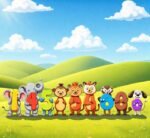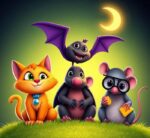- You are here:
- Home »
- words
- » Christmas Words That Start With M [LIST]

Christmas Words That Start With M [LIST]
Christmas is a season filled with joy, celebration, and traditions that bring people together. Each year, as the holiday season approaches, families and communities embrace the festive spirit through decorations, music, and gatherings. For those looking to add a bit more holiday cheer to their vocabulary, exploring Christmas words that start with the letter ‘M’ can offer a fun and creative way to enhance the festivities. From traditional symbols to modern expressions, ‘M’ words capture the essence of the season in a variety of ways.
The letter ‘M’ is especially rich in words that relate to Christmas, each evoking its own special meaning and connection to holiday celebrations. Whether you’re thinking of the magical atmosphere of the season, the merry moments shared with loved ones, or the classic imagery of mistletoe, the words that start with ‘M’ provide a wonderful reflection of the Christmas spirit. In this list, we’ll explore some of the most common and charming ‘M’ words that can bring more holiday magic to your vocabulary, from decorations to the emotions that make Christmas so memorable.
Christmas Words That Start With M
1. Manger
A manger is a feeding trough, typically made of wood or stone, where animals are fed. In Christian tradition, it is significant as the place where Jesus was laid after his birth in Bethlehem, according to the Bible.
Examples
- In the nativity scene, the baby Jesus was placed in a manger made of wood and straw.
- The manger was humble, symbolizing the simplicity of Christ’s birth.
2. Mistletoe
Mistletoe is a type of plant with white berries that is traditionally hung during Christmas. It is often associated with kissing, as it was believed to bring good luck or fertility, and was considered sacred in ancient cultures.
Examples
- People often hang mistletoe in doorways during Christmas to encourage couples to kiss.
- The tradition of kissing under the mistletoe dates back centuries, with various myths surrounding its magical properties.
3. Midnight Mass
Midnight Mass is a Catholic or Christian church service held at midnight on Christmas Eve. It commemorates the birth of Jesus Christ and marks the beginning of Christmas Day.
Examples
- Many Christians attend Midnight Mass on Christmas Eve to celebrate the birth of Christ.
- Midnight Mass is a deeply spiritual occasion, with beautiful hymns and a solemn atmosphere.
4. Mulled Wine
Mulled wine is a traditional beverage served during the holiday season, typically made by heating red wine with spices such as cinnamon, cloves, and nutmeg. Sometimes, fruit such as oranges or apples is added for extra flavor.
Examples
- Mulled wine is a popular festive drink made with red wine, spices, and fruit.
- At the Christmas party, guests warmed up with mugs of mulled wine, filling the air with the aroma of cinnamon and cloves.
5. Merry
The word ‘merry’ means cheerful, lively, and full of joy. It is often used in the holiday greeting ‘Merry Christmas,’ which expresses goodwill and festive cheer.
Examples
- People greet each other with ‘Merry Christmas’ during the festive season.
- The phrase ‘Merry Christmas’ is used to wish others happiness and joy during the holiday.
6. Mince Pie
A mince pie is a small, sweet pastry typically filled with a mixture of dried fruits, spices, and sometimes alcohol, often served as a Christmas treat. It is traditionally associated with the UK and parts of Europe.
Examples
- Mince pies are a traditional Christmas treat in the UK, filled with a mixture of dried fruits and spices.
- The aroma of freshly baked mince pies filled the house on Christmas morning.
7. Magical
Magical refers to something that seems extraordinary or enchanted, often evoking a sense of wonder and fantasy. Christmas, with its twinkling lights and festive spirit, is often described as a magical time of year.
Examples
- The Christmas lights gave the town square a magical glow, enchanting all who passed by.
- The night felt magical as families gathered around the Christmas tree to exchange gifts.
8. Snowman
A snowman is a figure made from snow, typically built by children during the winter season. It usually consists of three snowballs stacked on top of each other, with accessories like buttons, a scarf, and a carrot for a nose.
Examples
- Children build snowmen during the Christmas season when snow blankets the ground.
- The snowman had a carrot nose, coal eyes, and a scarf wrapped tightly around its neck.
9. Milk and Cookies
Milk and cookies are often left out by children for Santa Claus on Christmas Eve. The tradition is based on the idea of offering a snack to the jolly figure who delivers presents to children around the world.
Examples
- On Christmas Eve, many children leave a plate of milk and cookies for Santa Claus.
- The tradition of leaving milk and cookies for Santa is a way to honor the legend of St. Nicholas.
10. Magic
Magic refers to the mysterious or supernatural quality that can make something feel special or extraordinary. During Christmas, magic is often associated with the wonder and excitement of the season, such as the belief in Santa Claus.
Examples
- There was an air of magic at the Christmas party, with the tree twinkling and music filling the room.
- Christmas Eve always felt like a night when magic could happen, with surprises around every corner.
11. Muffin
Muffins are small, individual baked goods that can be sweet or savory. During Christmas, they are often flavored with seasonal ingredients like cranberries, spices, or citrus to complement the festive atmosphere.
Examples
- Christmas morning was greeted with the smell of freshly baked muffins filled with cranberries and orange zest.
- Muffins, especially those with festive flavors, are often served as part of a Christmas breakfast.
12. Manger Scene
A manger scene, also known as a nativity scene, is a depiction of the birth of Jesus Christ, often displayed during Christmas. It typically includes figures of the Holy Family, shepherds, wise men, and angels.
Examples
- The family set up a manger scene under the tree, complete with figurines of Mary, Joseph, and baby Jesus.
- In many homes, the manger scene is the focal point of the Christmas decorations.
13. Mistletoe Ball
A Mistletoe Ball is a formal or semi-formal event, often held around Christmas, where people come together to celebrate the holiday season. It is named after mistletoe, which is hung at the venue for the tradition of kissing.
Examples
- The Mistletoe Ball is a popular event held every year to raise funds for charity during the holiday season.
- Guests at the Mistletoe Ball enjoy dancing, festive food, and the tradition of kissing under the mistletoe.
14. Merry-Go-Round
A merry-go-round, also known as a carousel, is a rotating amusement ride featuring horses or other figures. During the Christmas season, merry-go-rounds are often set up at holiday fairs or Christmas markets.
Examples
- The children enjoyed a ride on the Christmas merry-go-round at the holiday carnival.
- The merry-go-round was decorated with festive lights and music, adding to the Christmas cheer.
15. Magnet
A magnet is a small, usually decorative item that can be attached to metal surfaces, often used as a souvenir or for personalizing spaces. Christmas magnets often depict festive scenes and symbols like Santa or Christmas trees.
Examples
- Christmas-themed refrigerator magnets are a popular gift, often featuring holiday icons like Santa, reindeer, and snowflakes.
- The family decorated the fridge with a collection of festive magnets that had been collected over the years.
16. Mantle
The mantle refers to the shelf above a fireplace, often decorated during the Christmas season with stockings, candles, garlands, or ornaments. It is a traditional spot for hanging Christmas stockings in many homes.
Examples
- The stockings were hung with care on the mantle, ready for Santa’s arrival.
- Over the Christmas holidays, the mantle was adorned with garlands, lights, and a star at the top.
17. Music
Christmas music includes a wide range of songs and carols that celebrate the season, ranging from religious hymns to secular festive songs. Music is an essential part of the holiday atmosphere, often played during gatherings, parties, and church services.
Examples
- Christmas music filled the air, from carolers singing door-to-door to holiday tunes playing on the radio.
- The sound of Christmas music brought back memories of past holidays spent with loved ones.
18. Marzipan
Marzipan is a sweet confection made from ground almonds and sugar, sometimes flavored with rosewater. It is commonly used in European holiday baking, often molded into decorative shapes for Christmas.
Examples
- Marzipan, a sweet almond paste, is often shaped into festive figures like fruits, animals, and Santa Claus during Christmas.
- The holiday table was adorned with marzipan treats, which were both beautiful and delicious.
19. Merry Christmas
Merry Christmas is a common phrase used to wish others happiness and joy during the Christmas holiday. It is often used in greetings, cards, and well-wishing messages around the world.
Examples
- At the end of their holiday card, they wished all their friends and family a ‘Merry Christmas and a Happy New Year.’
- ‘Merry Christmas’ is a universal greeting shared among people during the holiday season to express festive cheer.
Historical Context

The holiday season is rich with traditions and customs, many of which are steeped in centuries of history. Christmas, a Christian celebration of the birth of Jesus Christ, has evolved over the years to encompass a variety of cultural practices, symbolic figures, and festive vocabulary. Among the most enduring of these are the words associated with the season, many of which begin with the letter M. Understanding the historical context of these words can provide a deeper appreciation for the holiday’s multi-layered traditions.
The most significant Christmas-related words that begin with "M" are often tied to the development of Christian liturgical practices, European folklore, and the blending of secular and sacred celebrations. Words like Manger, Midnight Mass, Mistletoe, and Merry have their origins in historical rituals and customs that predate the modern Christmas we know today.
For example, the Manger—the humble feeding trough where Christ is believed to have been laid after his birth—is a central symbol in Christian nativity scenes. This simple word carries profound theological and historical significance, as it connects the nativity narrative to a humble, agrarian society. Similarly, Midnight Mass, a church service held at midnight on Christmas Eve, traces its roots to medieval Christian traditions, where the midnight hour was thought to be a time of divine presence. The word Mistletoe, with its ancient associations to fertility and seasonal renewal, symbolizes the bridging of pagan customs with Christian celebrations during the medieval period.
The history of these words is not just linguistic but also symbolic, connecting present-day Christmas traditions with practices from centuries past, and reflecting a rich cultural and religious blend of practices that span Europe and the wider Christian world.
Word Origins And Etymology
Delving into the origins and etymology of Christmas words that begin with M reveals a fascinating blend of linguistic influences, rooted in various languages and cultures.
-
Manger – The word manger comes from the Old French mangier, meaning "to eat," which itself is derived from the Latin manducare, meaning "to chew" or "to eat." This term reflects the humble nature of the place where the infant Jesus is said to have been placed after his birth. The manger is a symbol of modesty, contrasting with royal or lofty settings, and it emphasizes the humble beginnings of Christ’s life on Earth.
-
Midnight Mass – The term Midnight Mass is straightforward in its meaning, but its history is more complex. Midnight comes from Old English midniht, a compound word meaning “middle night,” while Mass comes from the Latin missa, meaning "dismissal" or "sending forth." It refers to the Christian liturgical service, and the tradition of holding a Mass at midnight on Christmas Eve dates back to the 4th century. Over time, it evolved from an early Christian custom into a deeply ingrained cultural practice throughout Europe.
-
Mistletoe – Mistletoe has a long history that predates Christianity. The word comes from the Old English misteltan, which is derived from the Proto-Germanic mistl, meaning "dung," and tan, meaning "twig" or "branch." This likely refers to the plant’s habit of growing on trees and the mistaken belief that its berries appeared from bird droppings. The use of mistletoe as a symbol in Christmas traditions may have its roots in ancient Druidic rituals, where it was considered a sacred plant with magical properties. By the Middle Ages, mistletoe had become associated with fertility, peace, and the Christmas celebration.
-
Merry – The word merry is an interesting example of a term that has evolved in its usage over the centuries. Derived from the Old English myrige, which means “pleasant” or “joyous,” the word merry has been associated with joviality and celebration for centuries. The phrase “Merry Christmas” first appeared in the early 19th century, popularized in part by Charles Dickens’ A Christmas Carol and the broader Victorian culture, which emphasized happiness, feasting, and good cheer as part of the Christmas experience.
Common Misconceptions
As with many holiday traditions, certain misconceptions surround Christmas words that begin with M. These misconceptions can range from misunderstandings about their origins to confusion about their cultural significance.
-
Merry vs. Happy – A common misconception surrounding the phrase "Merry Christmas" is the belief that "happy" and "merry" are interchangeable in this context. While they may seem similar, the two words have different connotations. Merry is often used to denote a more robust, active form of joy, while happy conveys a more calm, contented state. The traditional greeting "Merry Christmas" carries with it a sense of exuberant festivity, as opposed to the more subdued Happy Christmas. In fact, "Happy Christmas" was historically more common in England, particularly before the 19th century, but “Merry Christmas” became widespread with the publication of A Christmas Carol and subsequent cultural shifts.
-
Mistletoe and Kissing – Another misconception about mistletoe is its exclusive association with kissing. While mistletoe has long been part of Christmas decoration, its association with kissing likely stems from Norse mythology and ancient European customs surrounding fertility and good fortune. In earlier traditions, mistletoe was hung not only as a symbol of love but also as a peace-making gesture during conflicts. The practice of kissing under the mistletoe is a relatively modern addition, popularized in the 18th and 19th centuries, as romanticized by Victorian-era customs.
-
Manger as a Cradle – Some people assume that the manger in the nativity story was specifically a cradle or a crib for infants. While it is true that the manger served as a resting place for the baby Jesus, it was originally a feeding trough for animals. The idea of the manger as a cradle is a romanticized image that developed later, as the story of the nativity became more stylized in art and literature.
-
Midnight Mass and Christmas Eve – While Midnight Mass is indeed a popular tradition, it is often misunderstood as being the central or only important service on Christmas Eve. In many Catholic and Orthodox Christian traditions, the celebration of Christ’s birth begins with an evening vigil or mass before midnight, rather than precisely at the stroke of midnight. Additionally, in some cultures, the main Christmas celebration takes place not on Christmas Day itself but during the evening before, with Midnight Mass serving as the climax of this vigil.
Conclusion
Christmas words beginning with the letter M—such as Manger, Midnight Mass, Mistletoe, and Merry—are much more than mere vocabulary; they are windows into the deep and varied historical, religious, and cultural tapestry that defines the Christmas season. These words carry with them stories of ancient customs, religious rituals, and evolving cultural practices, tracing a path from pre-Christian Europe through the development of Christian traditions and the modern, secular holiday we know today.
Through their etymology and historical significance, we can gain a richer understanding of the symbols and practices that make Christmas such a unique and enduring celebration. Whether you’re contemplating the humble manger in which Christ was laid, sharing a kiss under the mistletoe, attending Midnight Mass, or simply wishing someone a Merry Christmas, these words resonate with centuries of history and meaning. So, the next time you use these festive terms, take a moment to reflect on the deep roots and rich layers of tradition that have shaped them into the beloved elements of Christmas we hold dear today.








